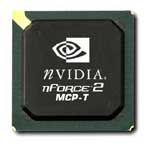 |
|
|
|
In the Forums... |
Posted: July 14, 2002 Written by: Davey McWatters NVIDIA nForce2 MCP/MCP-T  MCP and MCP-T are what is known as the south bridge of the chipset. While the north bridge controls things like the CPU, memory, and AGP, the south bridge controls most of the features that make NVIDIA’s nForce2 chipset so feature filled. This is one of the most feature packed south bridges the industry has ever seen. It will surely give the competition a run for its money. NVIDIA’s communication suite is a key element in both the MCP and the MCP-T versions of the south bridge. This suite controls the USB, Firewire, and integrated networking features of the motherboard. The MCP-T is a more feature filled version of the MCP chip, therefore it will offer users an enhanced communications suite. The enhanced version adds support for IEEE1394a (Firewire), and a 3Com IEEE802.3 MAC controller. The standard suite found on the MCP chip does not offer Firewire support nor does it offer a second the 3Com IEEE 802.3 MAC controller. NVIDIA’s IEEE802.3 MAC controller offers support for HomePNA2.0 so both chips will be able to use that to its advantage. Both south bridges offer support for up to 6 USB 2.0 ports that can operate at 1.2Mbps, 12Mbps, or 480Mbps. Your devices will dynamically be configured for best utilization of bandwidth. MCP-T’s FireWire support is fully compatible with both iLink and FireWire implementations of IEEE1394. NVIDIA’s DualNet is new to the nForce2 chipset and is only found on the MCP-T flavor south bridge. As the name suggests, it offers the user two concurrently operating Ethernet ports. The purpose of this is to make an nForce2 based computer your gateway to the Internet. If you run any Internet connection sharing software then you know the hassle of having to purchase and install two separate network cards in your PC. Now NVIDIA has integrated the two controllers into the motherboard to make sharing your Internet connection easier than ever before. Like the previous nForce chipset, nForce2 will utilize HyperTransport technology between the north and south bridge. HyperTransport is a high-speed serial bus that is able to offer tremendous bandwidth depending on how it is implemented. In NVIDIA’s case, its implementation of HyperTransport offers 800MB/s of bandwidth between the north and south bridges. NVIDIA also chose to keep its StreamThru technology implemented in the chipset. It allows isochronous devices to keep in constant connection with the CPU. An example of an isochronous device is the MAC controllers, which will always need new data processed. Both chips offer dual ultra ATA/133 controllers; however, it lacks any support for the upcoming SerialATA, which could in turn hurt the chipset a little bit. Other large chipset manufacturers, including VIA and Intel will have chipsets out soon that do support SerialATA natively. I wasn’t able to contact NVIDIA about any particular reason for this, but I will try to find out and update the article with the information they give me on the issue.  Another feature of the MCP-T flavor south bridge is NVIDIA’s APU or audio processing unit. It can already be found in Microsoft’s Xbox gaming console. The APU is actually very powerful and will give the most popular soundcards around some real competition. The APU contains five DSP’s (digital signal processors). Three of the five DSP’s are fixed and two are programmable. NVIDIA’s APU offers a Dolby Interactive Content Encoder, which will allow users to output a digital signal from SPDIF out to a receiver and output excellent sound quality. Support for up to a six speaker output is integrated into the APU. NVIDIA’s SoundStorm will offer users the most feature packed integrated solution available.  |
||
|
| |||
|---|---|---|---|